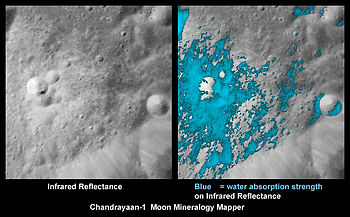Lunar water
[13] The presence of water may be attributed to two primary sources: delivery over geological timescales via impacts and in situ production through interactions of solar wind hydrogen ions with oxygen-bearing minerals.NASA's Ice-Mining Experiment-1 (set to launch on the PRIME-1 mission no earlier than late 2024) is intended to answer whether or not water ice is present in usable quantities in the southern polar region.[17] In 1834–1836, Wilhelm Beer and Johann Heinrich Mädler published their four-volume Mappa Selenographica and the book Der Mond in 1837, which established the conclusion that the Moon has no bodies of water on the surface nor any appreciable atmosphere.In February 1978 Soviet scientists M. Akhmanova, B. Dement'ev, and M. Markov of the Vernadsky Institute of Geochemistry and Analytical Chemistry published a paper claiming a detection of water fairly definitively.[6][7] Their study showed that the samples returned to Earth by the 1976 Soviet probe Luna 24 contained about 0.1% water by mass, as seen in infrared absorption spectroscopy (at about 3 μm (0.00012 in) wavelength), at a detection level about 10 times above the threshold,[25] although Crotts points out that "The authors... were not willing to stake their reputations on an absolute statement that terrestrial contamination was completely avoided.These were interpreted as indicating significant amounts of water ice trapped in permanently shadowed craters,[33] but could also be due to the presence of the hydroxyl radical (•OH) chemically bound to minerals.Based on data from Clementine and Lunar Prospector, NASA scientists have estimated that, if surface water ice is present, the total quantity could be of the order of 1–3 cubic kilometres (0.24–0.72 cu mi).[34][35] In July 1999, at the end of its mission, the Lunar Prospector probe was deliberately crashed into Shoemaker crater, near the Moon's south pole, in the hope that detectable quantities of water would be liberated.[22] As part of its lunar mapping programme, Japan's Kaguya probe, launched in September 2007 for a 19-month mission, carried out gamma ray spectrometry observations from orbit that can measure the abundances of various elements on the Moon's surface.[39] Japan's Kaguya probe's high resolution imaging sensors failed to detect any signs of water ice in permanently shaded craters around the south pole of the Moon,[40] and it ended its mission by crashing into the lunar surface in order to study the ejecta plume content.[41][needs update] The People's Republic of China's Chang'e 1 orbiter, launched in October 2007, took the first detailed photographs of some polar areas where ice water is likely to be found.During its 25-minute descent, the impact probe's Chandra's Altitudinal Composition Explorer (CHACE) recorded evidence of water in 650 mass spectra gathered in the thin atmosphere above the Moon's surface and hydroxyl absorption lines in reflected sunlight.[43][44] On September 25, 2009, NASA declared that data sent from its M3 confirmed the existence of hydrogen over large areas of the Moon's surface,[37] albeit in low concentrations and in the form of hydroxyl group ( · OH) chemically bound to soil.Because these polar regions do not experience the high temperatures (greater than 373 Kelvin), it was postulated that the poles act as cold traps where vaporized water is collected on the Moon.[50][51] In March 2010, it was reported that the Mini-SAR on board Chandrayaan-1 had discovered more than 40 permanently darkened craters near the Moon's north pole that are hypothesized to contain an estimated 600 million metric tonnes of water-ice.The nature, concentration and distribution of this material requires further analysis;[56] chief mission scientist Anthony Colaprete has stated that the ejecta appears to include a range of fine-grained particulates of near pure crystalline water-ice.[64] In May 2011, Erik Hauri et al. reported[65] 615-1410 ppm water in melt inclusions in lunar sample 74220, the famous high-titanium "orange glass soil" of volcanic origin collected during the Apollo 17 mission in 1972.[citation needed] In October 2020, astronomers reported detecting molecular water on the sunlit surface of the Moon by several independent scientific teams, including the Stratospheric Observatory for Infrared Astronomy (SOFIA).[69] October 26, 2020: In a paper published in Nature Astronomy, a team of scientists used SOFIA, an infrared telescope mounted inside a 747 jumbo jet, to make observations that showed unambiguous evidence of water on parts of the Moon where the sun shines.[84][85] It has been theorized that the latter may occur when hydrogen ions (protons) in the solar wind chemically combine with the oxygen atoms present in the lunar minerals (oxides, silicates, etc.)The temperature in these regions never rises above about 100 K (about −170 ° Celsius),[87] and any water that eventually ended up in these craters could remain frozen and stable for extremely long periods of time — perhaps billions of years, depending on the stability of the orientation of the Moon's axis.






the far sideMoon Mineralogy MapperChandrayaan-1lunar missionswater'sThe Moonwater vapordecomposed by sunlighthydrogenpermanently-shadowed cratersregolithlunar atmospherehydroxylAdsorbedapatiteNASA'sPRIME-1Leonardo da VinciCodex LeicesterWilhelm BeerJohann Heinrich MädlerCaltechlunar rockApolloApollo 14Luna 24SovietMare CrisiumClementine probelunar daysbistatic radarDeep Space NetworkpolarisationLunar Prospectorhydroxyl radicalShoemaker craterCassini–HuygensDeep ImpactAreciboKaguyagamma ray spectrometryChang'e 1hydroxidepyroxeneMoon Impact ProbeShackleton CraterCassinicold trapsMini-SARLunar Reconnaissance OrbiterCentaurAtlas VCabeus craterLunar Crater Observation and Sensing SatelliteLCROSShydratesMini-RFepithermal neutronlunar south polemelt inclusionsApollo 17upper mantlemolecular waterStratospheric Observatory for Infrared AstronomyPaul HertzLunar IceCubeCubeSatGoddard Space Flight CenterArtemis 1Lunar Trailblazerepsomiteblöditegypsumbassanitejarositecarbon monoxidehydrogen sulfideammoniasulfur dioxideethylenemethanolmercurymethanecometsprotonssolar windoxygenoxidessilicatesSolar radiationecliptic planeWhipple craterImpact glass beadssurface diffusionself-ionization of waterSubglacial lakes on MarsGroundwater on MarsIsotope analysisGiant Impact eventlunar habitationInner Solar SystemOuter Space TreatyMoon TreatyLuxembourgDonald Trumpexecutive orderIn situ resource utilizationLunar resourcesWater on MarsChandrayaan-2Lunar FlashlightLunaH-MapBibcodeSmithsonian MagazineWayback MachineThe HinduRandall AmsterThe Washington PostThe New York TimesThe IndependentWashington State UniversityOutlineInternal structureTopographyAtmosphereGravity field